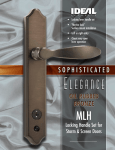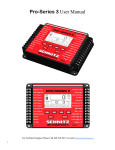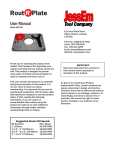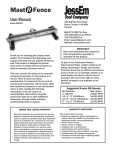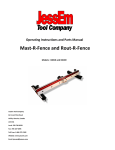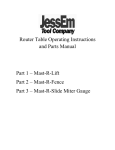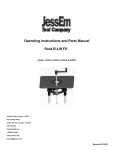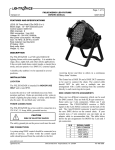Download Mortise Mill - JessEm Tool Company
Transcript
Mortise Mill User Manual Model #08100 61 Forest Plain Road, Orillia, Ontario, Canada L3V 6H1 866-272-7492 Toll Free 705-726-8233 Local Phone 705-327-0295 Fax Email: [email protected] Website: www.jessem.com IMPORTANT! WARNING - THIS PRODUCT IS FOR USE WITH A HAND DRILL ONLY! WARNING - DO NOT ATTEMPT TO USE THE MORTISE DRILL BIT (or any drill bit) IN ANY TYPE OF ROUTER DEVICE AS SERIOUS INJURY MAY OCCCUR. READ ADDITIONAL WARNINGS ON PAGE 2 BEFORE USING THIS PRODUCT Thank you for choosing this product from JessEm Tool Company. We appreciate your support and hope that our product serves you well. This product is designed to provide many years of reliable service provided it is used as intended and taken care of. This user manual will assist you in assembly and general operation of this product. It is not our intent to teach you about woodworking. It is assumed that you are an experienced woodworker with the basic skills and experience necessary to use this product safely. If after reading the following instructions, if you are unsure or uncomfortable about safely using this product we urge you to seek additional information through widely available woodworking books or classes. IMPORTANT! Read and understand the contents of this manual before assembly or operation of this product. As part of our Continuous Product Improvement Policy, JessEm products are always advancing in design and function. Therefore there may be differences between what is shown in our catalogs, website or at retail display and what is sold at time of purchase. We reserve the right to make positive changes to our products at our discretion. ADDITIONAL RECOMMENDED TOOLS AND ACCESSORIES 1/2” Hand Drill - Corded or Cordless 1,200 RPM (Min.) Vacuum (such as Shop Vac) Vac port is 2-1/4” I.D. Clamps for holding workpiece Hardware for mounting jig to workbench IMPORTANT SAFETY PRECAUTIONS CONTENTS OF PARTS BAG (2) - 5/16” X 3/8 shoulder bolts (1) - 3/4” steel washer (1) - 7/64” hex wrench (1) 1/8” hex wrench (1) 5/32” hex wrench (1) - 3/16” hex wrench (1) 3/8” I.D. stop collar w/set screw (5) Pre-cut tenons WARNING - DO NOT ATTEMPT TO USE THE MORTISE DRILL BIT (or any drill bit) IN ANY TYPE OF ROUTER DEVICE AS SERIOUS INJURY MAY OCCCUR. Drill bits are not designed for the high-RPM output of a Router and could cause the drill bit to bend and break and cause serious bodily injury. The mortise drill bits are for use in a hand drill only. DO NOT USE A ROUTER OF ANY TYPE WITH THIS PRODUCT. This product’s guide bushing and bearings are not designed for the highRPM output of any power router device. ! Before operating any machinery or power tool, read and understand all safety instructions in the owner’s manual for the tool or machine. ! If you do not have a manual, contact the manufacturer and obtain one before using any tool or machine. ! Always wear eye protection in compliance with ANSI safety standards when operating any power tools or machinery. ! Always use proper guards and safety devices when operating power tools and machinery. ! Carefully check drill bits before each use. Do not use if damage or defect is suspected. ! Do not exceed the recommended RPM for any drill bit. ! Do not wear loose clothing or jewelry that may catch on tools, machinery or equipment. ! Unplug the tool or machine when mounting or making any adjustments to mechanical performance. FIG. 1 ASSEMBLING THE LEVER SYSTEM 1. The lever system is partially pre-assembled from the box and needs to be attached to the Zip Slot Mortise Mill. Using one of the 5/16” shoulder bolts and a 5/32” hex key from the parts bag, first attach the long arm of the lever assembly to the tapped hole in the shaft mounting block (Fig. 1). OVERVIEW OF THE ZIP SLOT MORTISE MILL The Zip Slot Mortise Mill is a unique joinery system designed to cut mortises in wood for the purpose of mortise and tenon joinery. This product offers an excellent means of positioning a mortise in one workpiece and then offer the ability to accurately position a second workpiece to cut another mortise in an opposing position to the first workpiece. The result is two separate mortises that are perfectly aligned and can then joined with a loose tenon and glue. Insert washer here FIG. 2 2. To assemble the short arm of the lever system you will first insert a 3/4” steel washer under the short arm. Again using one of the 5/16” shoulder bolts and a 5/32” hex key from the parts bag attach the short arm of the lever assembly to the tapped hole in the extension of the carriage block. (Fig. 2). This Model 8100 comes with a 3/8” diameter mortising drill bit and matching 3/8” drill guide bushing. 2 ZIP SLOT MORTISE MILL COMPONENTS TOP VIEW MORTISE POSITION SCALE INDICATOR BLOCKS VACUUM PORT MORTISE POSITION SCALES CARRIAGE PLATE ADJUSTMENT KNOBS MORTISE LOCATOR MARKS CARRIAGE STOP ADJUSTMENT KNOB CARRIAGE STROKE SCALE DRILL GUIDE BUSHING FRONT VIEW VACUUM PORT DRILL GUIDE BUSHING SHAFT MOUNT BLOCK LEVER CARRIAGE STOP CARRIAGE PLATE STOCK LOCATING PLATE BEARING COVER PLATE CARRIAGE BLOCK BASE 3 STOCK LOCATING SCALES A B FIG. 3 FIG. 5 INSTALLING THE MORTISE DRILL BIT AND STOP COLLAR ADJUSTING THE CARRIAGE PLATE 1. Adjust the carriage plate by loosening the two brass carriage plate adjusting knobs (letter “A” in Fig. 4). Then slide the carriage plate into position while referring to the mortise position scales (letter “B” in Fig. 4). 1. Slide the stop collar onto the drill bit and using the 1/8” hex wrench, tighten the set screw to secure the stop collar in position. Because of the length of the drill guide bushing, thickness of carriage plate, etc., you will need to add 2.4 inches to the desired depth of the mortise you are cutting (Fig. 3). 2. The mortise position scales (letter “A” in Fig. 5) are used to position the mortise on the workpiece. The scale indicator blocks (letter “B” in Fig. 5) help reference the center of the mortise. For example, if you are using a 3/4” thick workpiece and you want the mortise positioned in the center, set the scale indicator blocks at 3/8” on the mortise position scales. Then re-tighten the carriage plate adjustment knobs to secure the carriage plate in the desired position. 2. Insert the drill bit into the drill chuck and tighten the bit securely (Fig. 3). B A Note: Although the scale indicator blocks (B) are preset in our factory. It may be necessary to make a slight adjustment of your own. The scale indicator blocks not only reference the scale to assist in positioning the mortise, they also help to align the carriage plate and keep the mortise parallel to the edge of the workpiece. If you find the sides of the mortise are not parallel to the workpiece or the indicator blocks are not accurately positioning the mortise, adjust as followsAccurately scribe a line along the length and center of a 3/4” thick board. Clamp the board to the base of the Mortise Mill and check the mortise locator marks under each side of the carriage block. See figure 7 for an example of using the mortise locator marks on the carriage plate. The mortise position scale indicator blocks should be pointing to 3/8” on the scale. SLID E SLI DE A FIG. 4 SETTING UP THE ZIP SLOT MORTISE MILL There are three easy steps you need to take to set-up the Zip Slot Mortise Mill. 1. Set the carriage plate to position the mortise in the workpiece. 2. Position the workpiece in one of two ways, visually, or by using the stock locating plate and stock locating scales. 3. Setting the carriage stroke to establish the length of the mortise. 4 A B A B FIG. 6 FIG. 8 POSITIONING THE WORKPIECE VISUALLY POSITIONING THE WORKPIECE USING THE STOCK LOCATOR PLATE AND SCALES 1. The next step is to position the workpiece. This can be done in either of two ways. You can position the workpiece visually by scribing a line along the center of the mortise (letter “A” in Fig. 6). Then scribe an intersecting line that indicates the centerline of the drill bit (letter “B” in Fig. 6). Keep in mind that when you set the carriage stroke, the scales are based on the centerline of the drill bit. So if you are using the 3/8” diameter mortise drill bit, half this dimension is 3/16”. So instead of scribing line “B” to indicate the end of the mortise, you need to scribe this line another 3/16” in from where the end of the mortise will actually be. 1. Another way to position the workpiece is to set the stock locator block ( letter “B” in Fig. 8) and use the stock locating scale (letter “A” in Fig. 8) to locate the desired position of the workpiece. ADJUSTING THE STOCK LOCATOR PLATE Using the 3/16” hex wrench loosen the two 1/4-20 socket head cap screws to position the stock locating plate (Fig. 8). The stock locating plate has a rail on the back side that slides in the top T-slot in the face of the Mortise Mill base. This rail will help keep the stock locator plate square and should be pressed tightly against the top or bottom edge of the T-slot to help keep it square. The stock locating plate also has an angled side and can be flipped upside down to position a workpiece at a 45 degree angle. A A B FIG. 7 C 2. Next position the workpiece under the carriage plate and against the base of the mortise mill. Line up the mortise locator marks on the carriage plate (Fig. 7) with the lines you scribed in step 1 (Fig. 6) above. Then clamp the workpiece securely to the front face of the base of the mortise mill. STOCK LOCATING PLATE STOP POSITION = A + B - C (A) = DISTANCE FROM EDGE OF STOCK (B) = WIDTH OF TENON (C) = RADIUS OF TENON FIG. 9 5 As shown in the example in Fig. 9, the diagram shows a 1-1/4” long tenon (letter “B”). This tenon is to be positioned 5/8” in from the edge of the stock (letter “A”) The tenon thickness is 3/8” with the radius being 3/16” (letter “C”). The formula would then be 1-1/4” + 5/8” = 1-7/8”. Subtract 3/16” and the stop position would be set at 1-11/16” to the left of “0” to cut this mortise in this length and position. A B DETERMINING THE CARRIAGE STROKE Because the carriage stroke scale references from the centerline of the mortise drill bit, you need to subtract the thickness of the tenon from the width of the tenon to determine where to set the carriage position on the scale (Fig. 11). For example, if you have a 2 inch wide tenon and you are using the 3/8” diameter mortise drill bit (for a 3/8” thick tenon) you would subtract 3/8” from 2” and you would then need to set the carriage stroke to 1-5/8” on the scale. With the carriage positioned all the way to the right side. Refer to the pointer at the base of the left side of the carriage block and move this left pointer to 1-5/8” on the carriage stroke scale. Then position the carriage stop against the left side of the carriage block and tighten the brass knob to hold the stop and set the length of stroke for the carriage. C FIG. 10 SETTING THE CARRIAGE STROKE 1. The final step in the set-up is to set the carriage stroke to give the desired length of the mortise. This is done by referring to the carriage stroke scale (letter “B” in Fig. 10) and using the adjustable carriage stop (letter “A” in Fig. 10) to set the carriage stroke. The carriage block also has a pointer on each side (letter “C” in Fig. 10) to help set the carriage position to the carriage stroke scale. FIG. 12 CLAMPING THE WORKPIECE HORIZONTALLY Clamp the workpiece in the horizontal position to mill a mortise along the side of the workpiece. Be sure the workpiece is positioned tight against the adjustable stock locating plate and the underside of the carriage plate. Also be sure to clamp the workpiece securely so that it does not move during the milling of the mortise (Fig. 12). CARRIAGE STROKE (A) = B - C (A) = CARRIAGE STROKE (B) = WIDTH OF TENON (C) = THICKNESS OF TENON C A B FIG. 11 6 2. With one hand holding the drill, insert the drill into the drill guide bushing. Place your other hand on the handle for the lever. As you pull the trigger on the drill begin moving the lever from side to side (Fig. 15). You should begin milling the mortise with very little to no downward pressure on the drill as you slide the lever from one end of the mortise to the other. This will give a cleaner cut to the top edge of the mortise. Once past the surface you can apply a little more downward pressure as needed. Continue milling with drill running and moving the lever from side to side until the desired depth is accomplished. FIG. 13 CLAMPING THE WORKPIECE VERTICALLY Clamp the workpiece in the vertical position to mill a mortise in the end of the workpiece. Be sure the workpiece is positioned tight against the adjustable stock locating plate and the underside of the carriage plate. Also be sure to clamp the workpiece securely so that it does not move during the milling of the mortise (Fig. 13). FIG. 16 CHECKING THE TENON FIT AND ALIGNMENT It is important to keep in mind that the scales, carriage stop and stock locating plate need to be considered as general reference guides only. Due to the multitude of variables in tenon dimensions and aligning the position of mortises it will be necessary to make test cuts and check for the desired fit of the mortise and tenons (Fig. 17) rather than rely on the scales alone. Once the correct settings are determined and the stops are set to achieve your desired results, repeatable accuracy is easy to achieve. FIG. 14 MILLING THE MORTISE 1. Once you have determined the position of the workpiece and clamped it securely in position, insert the drill bit into the drill guide bushing to begin milling a mortise (Fig. 14). WITH DRILL RUNNING GUIDE LEVER FROM SIDE TO SIDE LEVER FIG. 15 FIG. 17 7 Mast R Lift Excel Mite R Slide MODEL 06001 The First Integrated Lift And Phenolic Top Combination! MODEL 02201 Mast R Fence The First Rail Driven Miter Gauge Offering Unsurpassed Accuracy Mast R Lift MODEL 04001 The Heavy Weight Champion Of Aluminim Frame Router Table Fences! Rout R Lift FX MODEL 02101 From The Inventor Of The Router LiftThe Best Made Insert Lift On The Market! Find Out More About Our High Performance Tools At MODEL 02302 www.jessem.com A Great 2HP Lift at a 2HP price! Tools That Make A Difference!








